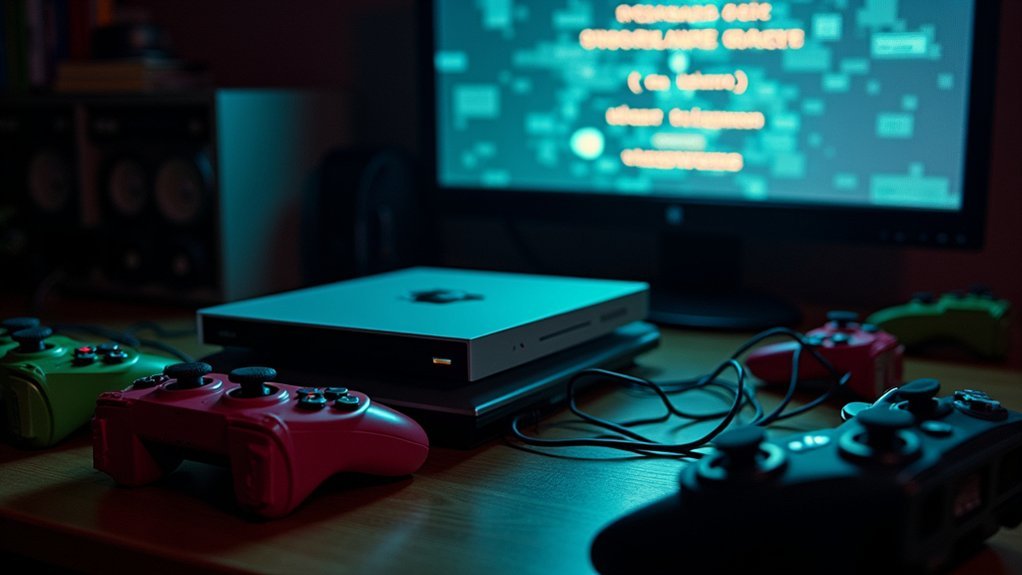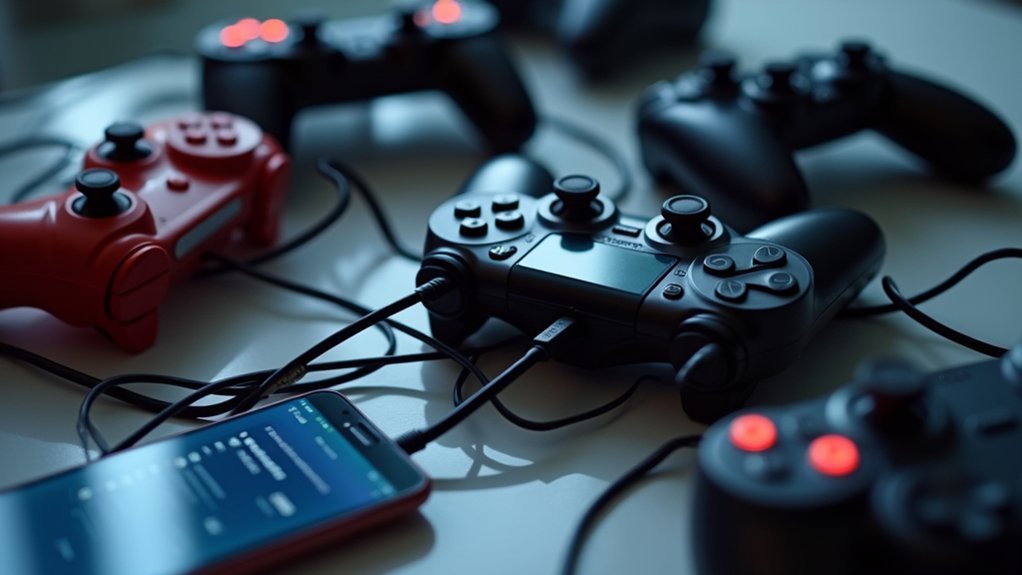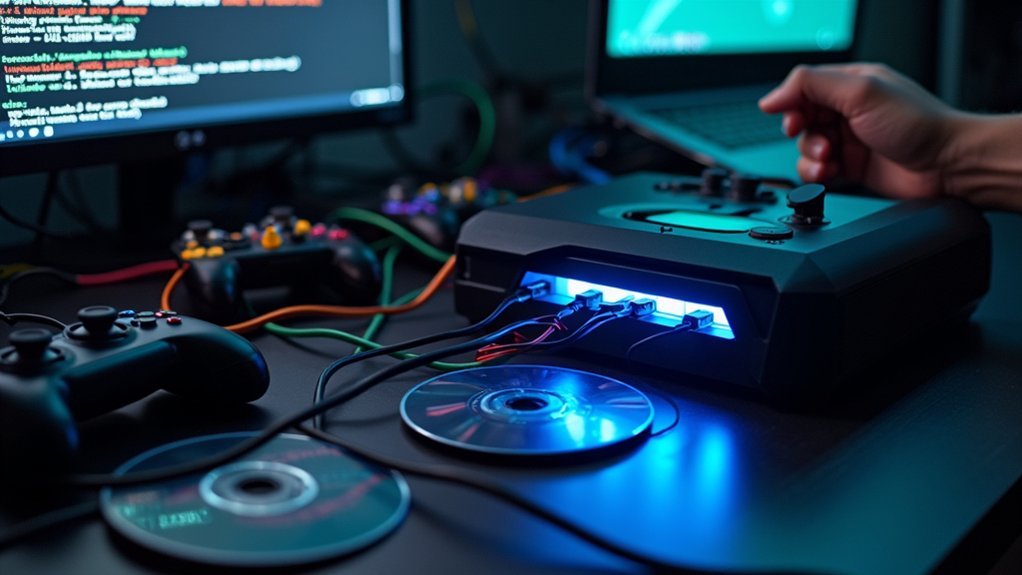Your multiplayer controller compatibility problems typically stem from outdated SDL2 libraries that can’t recognize modern controllers, Steam Input conflicts overriding game detection, Bluetooth interference when multiple wireless controllers compete for connection priority, missing drivers on the host system, Virtual Gamepad Type mismatches between devices during remote play, and platform-specific permission requirements blocking controller access. Third-party controllers often lack standardized support, creating inconsistent performance across games. Understanding these technical factors will help you identify the specific solutions needed for your setup.
Outdated SDL2 Library Causing Input Recognition Failures

When you’re experiencing controller recognition failures in multiplayer games, an outdated sdl2 library is likely the culprit behind your input woes. SDL2 handles controller input across platforms, and older versions frequently fail to recognize modern controllers like Xbox Wireless or PS4 gamepads.
Outdated SDL2 libraries are the primary cause of controller recognition failures in modern multiplayer gaming environments.
You’ll find that updating your SDL2 library resolves most controller compatibility issues. For macOS users, replacing the outdated libSDL2.dylib with version 2.0.16 or newer typically restores Xbox Wireless Controller functionality immediately.
Players consistently report that SDL2 updates fix previously unrecognized input problems. Games like Stardew Valley have documented compatibility issues with Xbox 360 and PS4 controllers stemming from outdated SDL2 dependencies.
Community-driven solutions focus on updating these libraries to enhance multiplayer games’ input recognition and guarantee seamless controller compatibility across different gaming platforms.
Steam Input Configuration Conflicts With Game Detection
Steam Input configuration conflicts frequently disrupt controller detection in multiplayer games, creating frustrating scenarios where your controllers appear connected but don’t function properly. These conflicts occur when Steam Input interferes with game-native controller recognition systems.
| Issue | Solution | Result |
|---|---|---|
| Controllers not recognized | Access game properties, select “Disable Steam Input” | Proper controller detection |
| Incorrect player count detected | Enable specific controller configuration support | Accurate multiplayer setup |
| Input lag or malfunction | Check Steam/game updates regularly | Improved compatibility |
To resolve controller configuration problems, you’ll need to disable Steam Input for specific multiplayer games through the controller dropdown menu. Additionally, verify Xbox, PlayStation, or Generic Gamepad Configuration Support are properly enabled in Steam settings. Regular updates help address ongoing compatibility issues between Steam Input and controller detection systems.
Bluetooth Connection Interference Between Multiple Controllers

When you’re running multiple Bluetooth controllers simultaneously, you’ll often encounter signal frequency overlap that causes intermittent disconnections and input lag during multiplayer sessions.
Your system may struggle with controller pairing priority issues, where it can’t determine which device should take precedence when multiple controllers compete for the same connection slot.
These multiple device recognition conflicts become particularly problematic when you’re trying to set up local multiplayer games, as your console or PC may fail to distinguish between controllers or randomly drop connections mid-game.
Bluetooth Signal Frequency Overlap
Although Bluetooth technology has revolutionized wireless gaming, its reliance on the crowded 2.4 GHz frequency range creates significant interference challenges when you’re running multiple controllers simultaneously.
Each controller broadcasts its unique signal within this same narrow spectrum, causing overlapping frequencies that confuse your gaming system. You’ll notice this interference most when competing signals from Wi-Fi routers, microwaves, and wireless headphones crowd the same frequency band.
The overlapping Bluetooth signals create conflicts that make your controllers behave erratically or disconnect unexpectedly during multiplayer sessions. Your game may struggle to distinguish between different controllers as their signals blend together.
This frequency congestion becomes particularly problematic in crowded environments where multiple wireless devices compete for the limited 2.4 GHz spectrum space.
Controller Pairing Priority Issues
Beyond frequency interference, your gaming system faces another challenge: determining which controller takes precedence when multiple devices compete for connection priority.
Controller pairing priority becomes critical when you’re connecting several Bluetooth controllers, as the last connected device often dominates the hierarchy. This creates multiplayer controller compatibility issues where earlier-paired controllers lose functionality or become unrecognized.
You’ll experience Bluetooth interference when multiple controllers register as identical device types, causing input conflicts and misinterpretation. Games with limited simultaneous connection support compound these problems.
To resolve priority conflicts, disconnect all controllers and reconnect them sequentially, starting with your primary device. Always verify controller settings through your game’s configuration menu and Steam’s Big Picture mode, ensuring only intended controllers remain active and properly prioritized for seamless multiplayer experiences.
Multiple Device Recognition Conflicts
Controller pairing priority sets the stage for an even more complex issue: recognition conflicts that occur when your gaming system struggles to distinguish between multiple connected devices.
When you connect multiple controller types simultaneously, especially Xbox controllers of the same model, your game may assign identical identifiers to different devices. This creates confusion where the system can’t properly recognize individual controllers, causing multiplayer sessions to fail.
Bluetooth connections compound this problem by introducing latency and interference between devices. Multiple controllers competing for bandwidth can result in inconsistent input recognition across all connected devices.
Recognition conflicts become particularly problematic when your game has limitations on simultaneous controller support. To resolve these issues, you’ll need to disconnect all controllers and reconnect them in a specific sequence, ensuring each device receives a unique identifier for proper multiplayer functionality.
Driver Installation Problems on Host Systems

When your controllers aren’t working properly in multiplayer sessions, the root cause often lies in missing or outdated drivers on the host system.
Driver installation problems frequently occur when the Parsec Virtual USB Gamepad controller driver isn’t present, preventing proper recognition and functionality. You’ll need to download the latest driver through Parsec settings and restart the application to apply changes effectively.
Missing Parsec Virtual USB Gamepad drivers cause controller recognition failures requiring immediate driver updates and application restarts.
Legacy drivers can create compatibility issues, so installing the most recent version helps avoid conflicts with newer operating systems.
Windows Server environments may require archived Xbox controller drivers and specific ViGEm driver versions.
Check your Device Manager for conflicting drivers like SCP Virtual Bus, which can interfere with installation and recognition of controllers on your host system.
Virtual Gamepad Type Mismatches in Remote Play
You’ll encounter controller recognition issues when your host and guest systems don’t share the same Virtual Gamepad Type configuration in Parsec.
Host-client driver conflicts become particularly problematic when one player uses an Xbox controller while another connects with a DualSense, creating input mapping errors that prevent proper gameplay.
These Xbox-DualSense configuration issues stem from different controller protocols attempting to communicate through mismatched virtual gamepad standards.
Host-Client Driver Conflicts
Although remote play sessions promise seamless multiplayer experiences, host-client driver conflicts frequently emerge when Virtual Gamepad Type settings don’t align between devices.
These host-client mismatches create controller compatibility issues that’ll disrupt your gaming sessions. If you’ve configured your host for Xbox 360 controllers but clients connect with DualSense controllers, you’ll encounter recognition failures and limited functionality.
Parsec specifically requires proper Virtual Gamepad Type configuration on the host machine.
When settings don’t match, clients won’t be recognized or they’ll experience reduced performance during remote sessions. You can prevent these conflicts by ensuring all connected controllers are updated and compatible with your chosen gamepad type.
Testing with identical controller types across all devices helps identify driver conflicts before introducing mixed hardware setups.
Xbox-Dualsense Configuration Issues
Xbox and DualSense controllers create specific configuration challenges since Parsec’s Virtual Gamepad Type recognition system can incorrectly identify these devices, leading to input failures during remote multiplayer sessions.
You’ll need to manually configure Parsec’s Virtual Gamepad Type settings to match your intended controller. When the host system misidentifies your DualSense as an Xbox controller (or vice versa), input mapping becomes inconsistent, causing gameplay confusion.
Essential configuration steps include:
- Set Virtual Gamepad Type to match your specific controller (DualSense/Xbox) in Parsec settings
- Connect guest controllers via USB for proper recognition
- Update controller drivers to prevent compatibility issues
- Verify input mapping consistency between different controller types
Without proper Xbox-DualSense configuration, you’ll experience conflicting input responses that disrupt seamless multiplayer experiences and require manual remapping to restore functionality.
Controller Mode Switching During VR Sessions
When you’re deep into a VR multiplayer session, nothing disrupts the experience quite like your controller mode switching without warning. This automatic switching occurs when your VR system detects different controller types and changes input settings accordingly, creating chaos in multiplayer environments.
You’ll face compatibility issues when your system’s default controller mode doesn’t match what you or other players prefer. Different controller types used simultaneously can cause major problems, especially when games require specific configurations for each player.
If you don’t set the correct mode, your inputs might be misinterpreted or completely ignored.
Input lag makes everything worse during mid-session mode switches, as your system needs time to calibrate new input methods, disrupting gameplay flow and frustrating everyone involved.
Platform-Specific Permission Requirements for Controller Access
Beyond hardware conflicts, your controller’s ability to function properly depends heavily on whether your operating system grants the necessary permissions for device access.
Each platform handles controller access differently, creating unique compatibility challenges that can disrupt multiplayer sessions.
Here’s what you need to know about platform-specific requirements:
- Windows – Grant proper permissions for controller drivers to guarantee device recognition and prevent access conflicts.
- macOS 11+ – Enable specific Bluetooth permissions for Xbox and DualShock controllers to operate seamlessly.
- Android – Check varying controller access permissions and install firmware updates for enhanced gamepad compatibility.
- Linux – Install kernel drivers and adjust system permissions to enable full controller functionality.
Understanding these platform differences helps you troubleshoot access issues before they impact your gaming experience.
Hardware Compatibility Issues With Third-Party Controllers
While first-party controllers undergo rigorous testing with game developers, third-party alternatives often create unexpected compatibility hurdles that can derail your multiplayer sessions.
Third-party controllers frequently lack standardized support, causing inconsistent performance across different games and platforms. Many don’t fully implement required protocols like Xinput or DirectInput, making games struggle to recognize them properly.
You’ll encounter input confusion when button mappings don’t align with game expectations, particularly frustrating during competitive multiplayer moments.
Driver updates are often infrequent, leaving your controller incompatible with newer games. Most problematically, third-party controllers introduce latency and responsiveness issues that become glaringly obvious in fast-paced multiplayer scenarios.
These compatibility issues can give opponents unfair advantages while hampering your gaming experience considerably.
Emulator Configuration Errors in VR Gaming Environments
As VR gaming environments add complexity to emulator setups, controller configuration errors become exponentially more problematic during multiplayer sessions. Your emulator configuration directly affects how multiple controllers function together in virtual reality.
These critical issues can derail your multiplayer experience:
- Improper controller mappings – Your emulator fails to recognize or differentiate between connected controllers, creating input conflicts.
- Incorrect virtual gamepad settings – Manual configuration mistakes result in unresponsive controls during gameplay.
- Outdated emulator software – Compatibility issues with newer controllers disrupt multiplayer sessions.
- Motion tracking complications – VR features cause certain controllers to be ignored or misidentified.
You’ll need to verify player settings are enabled for multiple controllers and multiplayer modes, as these directly influence simultaneous controller connectivity and functionality.
Frequently Asked Questions
Can Other Devices Interfere With an Xbox Controller Connecting?
Yes, other devices can interfere with your Xbox controller’s connection. USB devices sharing bandwidth, Bluetooth devices on 2.4 GHz frequency, and conflicting software drivers can all disrupt your controller’s recognition and functionality.
How to Fix Xbox One Controller Connectivity Issues?
Check your controller’s battery level and replace if low. Update firmware through Xbox Accessories app, disconnect interfering USB devices, enable Steam Input for games, and use powered USB hubs for multiple controllers.
How to Make an Xbox Controller Pairable?
You’ll need to charge your controller first, then press and hold the Xbox button to turn it on. Next, press the small pairing button until the logo flashes.
Why Is My Controller Malfunctioning?
Your controller’s malfunctioning because you’ve got outdated drivers, connection conflicts from multiple controllers, Steam Input interference, game incompatibility issues, or hardware problems like faulty Bluetooth connections that need troubleshooting.
In Summary
You’ll solve most multiplayer controller issues by updating your SDL2 library and checking Steam Input settings first. Make sure you’re pairing controllers one at a time to avoid Bluetooth interference, and verify you’ve got the right drivers installed. Check your platform’s controller permissions, especially on mobile devices. If you’re using third-party controllers or VR setups, double-check compatibility and emulator configurations before troubleshooting further.





Leave a Reply